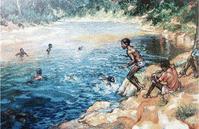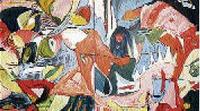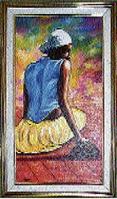
Anthony Wilson's 'Swimming Hole', represented on an Air Jamaica calendar. Depicted are Jamaican youths swimming in the Rio Cobre, St Catherine. - File photos
Allowing your treasured artwork to deteriorate is one sure way for them to lose their value. Succeeding generations will also not have the pleasure of viewing them in the years to come.
Damage can be seen in cracks in the paint, torn canvas, cracked or split wood, loose or missing paint, or a discoloured, darkened or faded surface.
Such damage is caused by handling or accidents, temperature changes and direct sunlight. Damage can also be caused, over time, by natural or artificial light and inappropriate or inadequate framing.
The experts note that handling is a major cause of damage to artworks.
Every move holds the risk of damage. Do not transport a painting in an unheated vehicle in cold weather. When it becomes necessary to handle or move a painting, avoid touching the paint surface or the back of the canvas.
Wrapped and sealed

This colourful oil on canvas abstract painting, titled 'Diptych', depicts the flavour of Monique Rollins' art exhibition, held earlier this year at The Shoppes at Rose Hall in Montego Bay.
Do not apply any kind of pressure to the back of a canvas - cracks in the paint may develop. While being transported, the painting's wrapping or package should be moisture- and water- resistant, and wrapped and sealed in such a way to guard against changes in relative humidity.
Paintings are best protected with rigid backing, such as corrugated/fluted plastic sheet, which helps to reduce the effect of rapid changes in relative humidity around the painting, while providing some physical protection from pressure or direct contact against the back of the canvas, and will reduce vibration caused by handling or moving.
Damage to paintings is also caused by direct sunlight. This causes fading of certain pigments and other problems.
Exhibit on dividing walls
The experts advise that it is best to exhibit paintings on dividing walls within a building, rather than on perimeter walls where temperature fluctuations will be greater and condensation can occur.
If you are going to place paintings on uninsulated exterior walls, it may help to place small rubber spacers on the back of the frame to increase air circulation.
When lighting paintings, you should use indirect lighting.
Lights that attach to the top of the frame and hang over the picture are not recommended, as they provide a harsh glare, illuminate and heat the painting unevenly, and can fall into the artwork, causing damage.
On the other hand, indirect sunlight, recessed lighting, or ceiling-mounted spotlights are best for home installations.
Some recommend halogen lamps, but halogen bulbs emit high levels of ultraviolet light. Soft, indirect lighting is best.
Dr David Boxer, chief curator at the National Gallery in Kingston, notes that one should always keep paintings, especially watercolours, out of direct sunlight and away from too much light in general.
He also strongly suggests that art owners get a professional to clean or supervise cleaning. If you are going to 'dust' your paintings, then a soft feather duster is recommended.
Information sources: http://www.preservation.gc.ca and http://aic.stanford.edu

Painting by Peter Peart.

Paintings on display at a recent exhibition.

